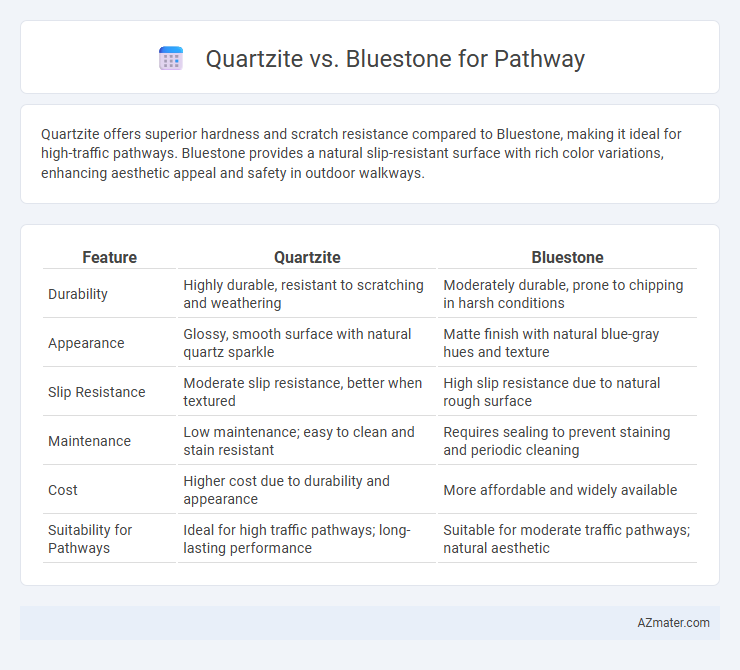Quartzite offers superior hardness and scratch resistance compared to Bluestone, making it ideal for high-traffic pathways. Bluestone provides a natural slip-resistant surface with rich color variations, enhancing aesthetic appeal and safety in outdoor walkways.
Table of Comparison
| Feature | Quartzite | Bluestone |
|---|---|---|
| Durability | Highly durable, resistant to scratching and weathering | Moderately durable, prone to chipping in harsh conditions |
| Appearance | Glossy, smooth surface with natural quartz sparkle | Matte finish with natural blue-gray hues and texture |
| Slip Resistance | Moderate slip resistance, better when textured | High slip resistance due to natural rough surface |
| Maintenance | Low maintenance; easy to clean and stain resistant | Requires sealing to prevent staining and periodic cleaning |
| Cost | Higher cost due to durability and appearance | More affordable and widely available |
| Suitability for Pathways | Ideal for high traffic pathways; long-lasting performance | Suitable for moderate traffic pathways; natural aesthetic |
Introduction to Quartzite and Bluestone Pathways
Quartzite pathways offer exceptional durability and a natural sparkle that enhances outdoor spaces, thanks to their metamorphic origin and high silica content. Bluestone pathways feature a distinctive blue-gray hue and fine-grained texture, derived from sandstone, lending a classic and elegant look perfect for walkways and patios. Both materials provide slip resistance and weather resilience, making them popular choices for sustainable and aesthetically pleasing pathway designs.
Key Characteristics of Quartzite
Quartzite is a highly durable, non-porous natural stone formed from sandstone under intense heat and pressure, making it resistant to scratching and weathering--ideal for high-traffic pathways. Its crystalline texture offers a unique, glossy finish with variations in color that range from white to gray and subtle earth tones, enhancing aesthetic appeal. In comparison to bluestone, quartzite boasts superior hardness and longevity, requiring minimal maintenance while providing excellent slip resistance for safe walkways.
Key Features of Bluestone
Bluestone offers exceptional durability and slip resistance, making it ideal for pathway surfaces exposed to varying weather conditions. Its natural iron content provides a unique blue-gray color that enhances aesthetic appeal while resisting fading and wear. Bluestone's fine-grained texture allows for easy cutting and installation, ensuring precise fitting and long-lasting performance in outdoor pathways.
Visual Appeal: Color and Texture Comparison
Quartzite offers a striking visual appeal with its vibrant, shimmering surface, characterized by a range of colors including white, gray, pink, and blue, enhancing pathways with a natural sparkle and unique veining patterns. Bluestone provides a more muted and earthy aesthetic, featuring predominantly deep blues, grays, and greens with a fine-grained, smooth texture that creates a classic and elegant appearance. The choice between quartzite and bluestone for pathways hinges on the desired color vibrancy and surface texture, where quartzite delivers a bold, dynamic look while bluestone offers subtle sophistication and uniformity.
Durability and Weather Resistance
Quartzite offers superior durability and exceptional weather resistance for pathways, resisting scratching, chipping, and heat damage due to its natural metamorphic composition. Bluestone, while attractive and moderately durable, tends to be softer and more porous, making it prone to wear, staining, and freeze-thaw damage in harsh climates. For long-lasting pathways in variable weather conditions, quartzite provides a more robust and maintenance-friendly option compared to bluestone.
Maintenance Requirements
Quartzite pathways demand minimal maintenance due to their natural resistance to scratching, staining, and weathering, making them ideal for high-traffic areas. Bluestone, while aesthetically pleasing with its smooth texture and rich blue-grey hues, requires regular sealing and cleaning to prevent water damage, staining, and moss growth. Homeowners seeking durability with low upkeep often prefer quartzite, whereas those prioritizing color and texture may choose bluestone despite its higher maintenance needs.
Slip Resistance and Safety Factors
Quartzite offers superior slip resistance for pathways due to its natural textured surface and hardness, making it safer in wet conditions compared to bluestone. Bluestone, while visually appealing with a smoother finish, may require additional treatments to enhance traction and prevent slips. Choosing quartzite enhances safety by minimizing fall risks and providing durable footing in various weather conditions.
Cost and Installation Differences
Quartzite pathways typically cost between $7 and $15 per square foot, often higher than bluestone, which ranges from $6 to $12 per square foot, reflecting differences in quarry location and material hardness. Installation of quartzite requires specialized cutting tools and can be more labor-intensive due to its dense, durable nature, potentially increasing labor costs. Bluestone is easier to cut and lay, making installation faster and generally less expensive, but it may require more frequent sealing to maintain its appearance over time.
Sustainability and Environmental Impact
Quartzite pathways offer high durability and require minimal maintenance, reducing long-term resource consumption and environmental disturbance. Bluestone, sourced from sedimentary rock, often involves less intensive quarrying processes, promoting lower carbon emissions during extraction. Both materials are natural and biodegradable, but choosing locally sourced options further decreases transportation impact, enhancing overall sustainability for pathway construction.
Best Applications: Which Stone Suits Your Pathway?
Quartzite offers exceptional durability and resistance to abrasion, making it ideal for high-traffic pathways requiring long-lasting performance, while its natural crystalline texture provides skid resistance. Bluestone presents a softer, more refined surface with a distinctive blue-gray hue, suited for decorative pathways in residential gardens or patios where aesthetic appeal and moderate durability are prioritized. Choosing between quartzite and bluestone depends on factors such as foot traffic volume, desired slip resistance, and visual style preferences for the pathway installation.

Infographic: Quartzite vs Bluestone for Pathway
 azmater.com
azmater.com